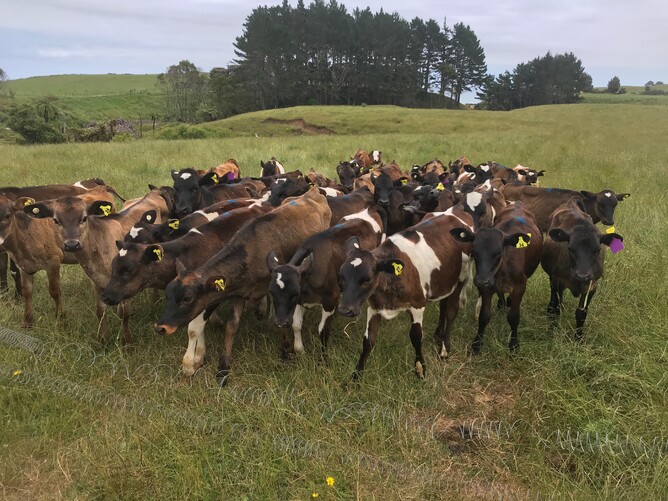Facial eczema (FE) is a challenge for many New Zealand farmers. Affected cattle can suffer with skin irritation and peeling, internal damage to the liver and other organs, and it sometimes results in death. FE also leads to a drop in milk production.
For farmers in regions prone to FE, it can be extremely frustrating – but genetics can offer a long-term solution, as one Taranaki farmer found out.
“We are highly prone to facial eczema here in North Taranaki,” says farmer Gary Phillips, who, together with wife Melynda, runs an organic dairy farm at Urenui, in North Taranaki. They have 160 milking cows on a 60-0hectare farm.
Until five or so years ago, they were badly affected by FE. More than one in 7-8 of their cows were developing the disease – which resulted in drying off stock early, and treating and sometimes culling affected cattle.
“As a farmer, it’s very hard to deal with facial eczema in your animals. When one-third or one-half of the herd gets facial eczema, it’s one of the most devastating things you ever can see,” says Gary.
Facial eczema is caused by the toxic spores of a fungus, Pithomyces chartarum, which grows in dead litter at the base of pasture in warm, moist conditions. It is more prevalent in summer and autumn (January through to May) when grass temperatures and humidity is higher.
When the toxin, sporisdesim, is ingested by cows, it damages the liver and bile ducts, and also causes skin inflammation.
There is no cure for FE, although many farmers use zinc or pasture sprays to reduce risk and animal reaction to a challenge. Often, affected cows are ‘dried off’ earlier, to reduce pressure on their liver, and in some cases cows can take up to 12 months to recover fully. Affected cows can succumb months after a challenge due to impaired liver function at a time of stress like calving. There may be additional costs with starter drench to boost metabolic function, vitamin B12 supplementation and veterinary costs.
CRV Ambreed offers farmers a genetic solution with its stable of FE-tolerant bulls, which enables farmers to breed cows who are less likely to react to a FE challenge.
The Phillips have been using CRV Ambreed’s FE-tolerant genetics across their cows since 2012.
Their CRV Ambreed rep John Preece played an important role in introducing them to using genetics as a solution to facial eczema. “When we were sitting down at the table with John, we told him our biggest problem was with eczema and we wanted something to improve the cows’ eczema tolerance,” says Gary. “He said, ‘well actually, we do have something like that.’ So we signed up on the spot.”
He says using CRV Ambreed’s FE-tolerant genetics is a smart long-term solution for their farm. Now, they have had three years of milking the progeny of sires with increased FE-tolerance, and also have heifers and calves coming through that have been bred from daughters of CRV’s FE-tolerant bulls.
“Everything seems to be working well,” says Gary. “We no longer have to treat those cows – for our calves, we were drenching regularly before, but the last three years we haven’t had to do anything at all to the animals with increased tolerance.”
Instead of up to half of his stock developing clinical eczema, the cows bred for FE-tolerance “didn’t get anything”, much to Gary and Melynda’s relief.
“Three years ago was a bad year for eczema in the region, and a lot of surrounding farms lost stock, but we floated on through,” says Gary.
New Zealand endured one of the worst facial eczema (FE) seasons in years in 2015 when spore counts ballooned in the North Island and parts of the South Island to the highest in a decade, and many herds had a large number of cows with clinical facial eczema.
CRV Ambreed has been offering semen from bulls with an increased tolerance to facial eczema since 2011, following research that discovered how to identify bulls with improved FE-tolerance.
Now about 17 per cent of CRV Ambreed’s 150-strong bull catalogue has increased tolerance to facial eczema, across the Crossbred, Friesian and Jersey categories.
CRV Ambreed’s Managing Director Angus Haslett says the company’s genetics gives farmers another tool in the tool box, especially when dealing with environmental conditions outside their control.
“Our genetics gives farmers a safe, environmentally sound solution to improving their herd that will save them money in the long run. It means less zinc is used, and farmers are investing in breeding cows who are not afflicted with this terrible disease, long-term.”
For the Phillips, their organic status was another reason to choose CRV’s FE-tolerant genetics. Although zinc is fine, if the cows get sick they can’t use antibiotics. Chemicals and fungicides are also a no-no.
The farm at Urenui has been in Gary’s family for 103 years, and the farm has been organic for about six or seven years.
There is a sense of pride in their farm and its legacy, and knowing they are improving their herd for the future. “Using CRV’s genetics increases our cows’ longevity. There isn’t the same turnover we used to get. We see it with these cows with increased tolerance to FE,” says Gary.
The Phillips’ also chose CRV Ambreed for other reasons – in particular they wanted to breed cows that were suited to their challenging terrain. “We have two contours of land here – flat top country and river flats, and in some places, it’s a 200 foot drop from the races around the top,” says Gary. “We couldn’t have big black and whites up there, we needed a ‘Kiwi cross’ – not too big and with sure footing.”
That meant choosing sires that had good feet, weren’t too big, and had other positive traits such as good udders and good production.
“Genetics have helped us improve our herd a lot,” says Gary.

